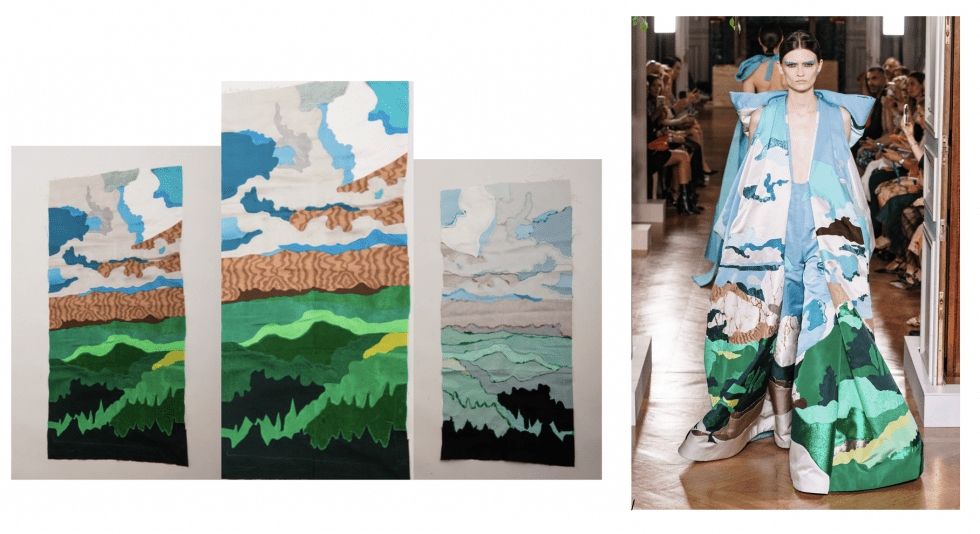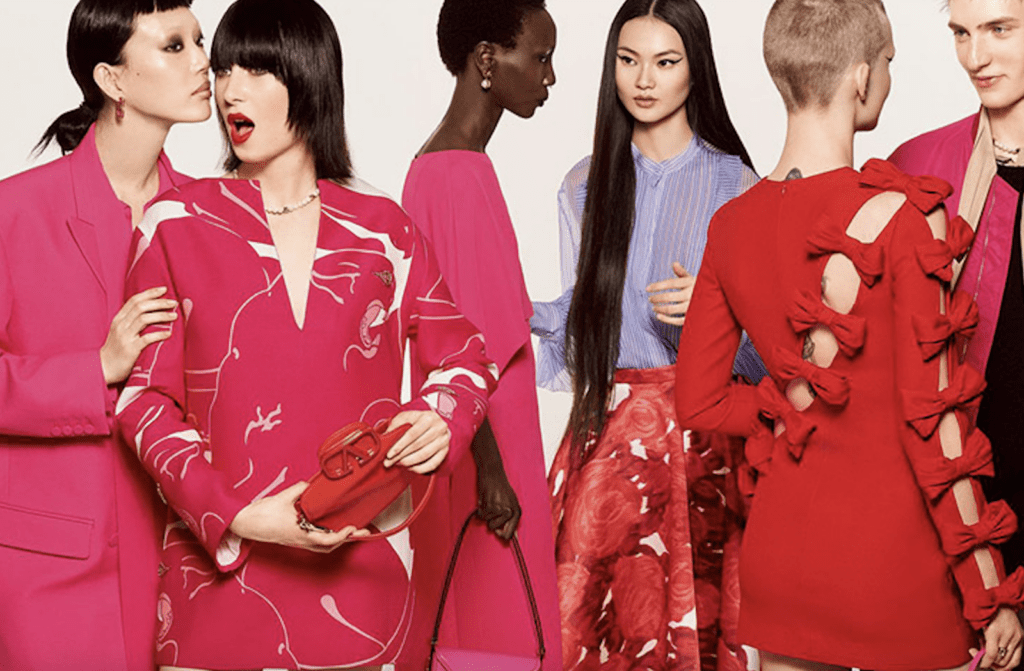A New York federal court has doubled-down on its decision to compel arbitration and stay a copyright infringement and trade secret misappropriation lawsuit waged against Valentino by one of its former longstanding suppliers. In an order on Tuesday, Judge Mary Kay Vyskocil affirmed her March order in the case that Mrinalini, Inc. filed in March 2022, accusing Valentino S.p.A. and its American arm Valentino U.S.A., Inc. (collectively “Valentino”) of “repeatedly stealing its copyrighted fashion designs and misappropriating the unique stitching technique that [it] developed,” thereby, giving rise to copyright infringement, trade secret misappropriation, unfair competition, and breach of contract claims.
Deciding to compel arbitration and stay the case this spring (as first reported by TFL), Judge Mary Kay Vyskocil of the U.S. District Court for the Southern District of New York stated that the Purchasing Agreement that Valentino and Mrinalini entered into in 2014 – which Mrinalini claims that Valentino breached – contains language that “expressly commits to arbitration ‘any dispute … associated or connected to [the agreement’s] execution, interpretation, enforcement, [or] validity.’” The arbitration clause also extends to “the question of whether Mrinalini’s claims set out an arbitrable dispute,” the judge held.
To date, the parties have disagreed over what constitutes an arbitrable matter under their Agreement. While Valentino pushed for dismissal and arbitration, New York-based Mrinalini argued that its claims fall outside of the scope of the arbitration clause, as the Agreement “relates to only one aspect of the parties’ relationship – [its] manufacturing of products based on Valentino’s designs.” Meanwhile, it claimed that the dispute at hand centers on “an entirely separate aspect of their relationship: Mrinalini’s manufacturing of products using its own designs,” and as a result, the matter should proceed in court.
Against that background and given that the parties’ Agreement “clearly and unmistakably” assigns to the arbitrator the question of what constitutes an arbitrable dispute, Judge Vyskocil granted Valentino’s motion to compel almost exactly a year after the case was first filed.

In addition to granting Valentino’s arbitration motion, the court denied Mrinalini’s bid to enjoin a separate – but related – arbitration that Valentino S.p.A. initiated in Italy in February 2022. Ahead of Mrinalini filing suit in the U.S., Valentino sought a declaration that it “does not owe Mrinalini any money for using textile swatches that Mrinalini had provided to it,” and also alleged that Mrinalini improperly registered various designs with the U.S. Copyright Office. (Adding another layer to the dispute, around the same time, Valentino S.p.A. filed a separate action in court in Milan, seeking a declaration that it did not violate any of Mrinalini’s trade secrets or “commit any other non-contractual offense, such as unfair competition.”)
Refusal to Reconsider
In the wake of Judge Vyskocil’s March 1 order to compel arbitration, Mrinalini urged the court to reconsider. The bottom line: Mrinalini claimed that in concluding that it consented to having an arbitrator decide issues of arbitrability, the court “overlooked that the definition of the term ‘Agreement’ not only includes the [2014 Agreement, itself], but also any purchase orders.” Without these purchase orders, which were not produced in the case, the court could not decide whether the relevant disputes were “connected to the Agreement” and thus, whether the disputes were arbitrable, per Mrinalini.
Fast forward to June 6, and the court sided with Valentino yet again. In her order denying reconsideration, Judge Vyskocil held that Mrinalini’s argument that the court did not consider all of the relevant documentation is “misguided.” The court “did not determine whether the relevant disputes were connected to the Purchasing Agreement,” according to Judge Vyskocil. Instead, merely concluded that “the question of arbitrability – i.e., the question of whether those disputes are connected to the Agreement – is one for the arbitrator, not the Court.”
Since reconsideration of an opinion of the court is “an extraordinary remedy in part because of the need to preserve scarce judicial resources,” Judge Vyskocil held that Mrinalini’s “meritless” motion “abuses those resources,” and denied its motion for reconsideration.
A Note on Trade Secrets: The most recent rounds in this multi-pronged case have focused on the arbitrability of the issues, but the case more broadly stems from Valentino’s alleged misappropriation of Mrinalini’s proprietary “sewing techniques like its ‘Intarsia’ technique,” which it says is “an intricate way to join several pieces of fabric into a rich and textured whole,” has “resulted in materials not seen before in the industry,” and has become “heavily in demand in the high fashion world.” Mrinalini contends that in furtherance of its alleged infringement and misappropriation, representatives for Valentino “insisted on visiting a plant where authorized workers were using the technique” and sought out specific details about the technique, including photos and videos from the manufacturing process. Mrinalini has argued that it shared such information with Valentino – albeit “only after Valentino agreed to keep the photos and video confidential.”
This agreement was “at least implied if not express,” Mrinalini asserts, noting that the brand “later affirmed its obligations under the agreement in writing.”
Despite agreeing to keep the information confidential, Mrinalini alleges that Valentino employees shared the proprietary stitching techniques with “other suppliers, including Mrinalini competitors, apparently in an unscrupulous effort to source … large quantities of clothing for Valentino … [from] the cheapest supplier, all without permission from Mrinalini.” Beyond that, Valentino allegedly “induced another [one] of its suppliers, Shevie, to hire people Mrinalini had trained in the Intarsia technique,” which Valentino and Shevie did, per Mrinalini, “to gain improper access to the Intarsia technique and misappropriate Mrinalini’s trade secret for [its own benefit].”
Reflecting on trade secret protections, which extend to valuable and confidential business information that provides a competitive advantage to a company or organization, Baker & Hostetler’s Linda Goldstein, Daniel Kaufman, Amy Ralph Mudge, and Randal Shaheen previously stated that “designs and the techniques that make them possible [may be] inseparable in the final product, [but] they invoke different rules when it comes to liability.”
“If you’re incorporating another company’s product into your offerings, you need to be vigilant about any attempt to reproduce the product on your own, or mimic any aspect of its manufacture, especially if the other company has been clear about the proprietary nature of the techniques,” they note. “Despite the unfortunate videotaping incident, Mrinalini claims it took ‘reasonable measures’ to protect the stitching secret – an important part of establishing its misappropriation claim.”
The case is Mrinalini, Inc v. Valentino S.p.A., et al., 1:22-cv-02453 (SDNY).














